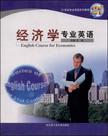经济学专业英语
出版时间:2006-6 出版社:哈尔滨工程大学出版社 作者:王波 页数:263
Tag标签:无
内容概要
《21世纪专业英语系列教程:经济学专业英语》精选原版美英专业教材与论文,语言地道、规范,内容逻辑严谨、体系规整,有助于大学经济学专业学生的专业英语学习,为双语教学打好基础。 《21世纪专业英语系列教程:经济学专业英语》由24个单元组成,第1单元至第3单元研究经济学的含义及分类;第4单元到第7单元研究消费需求与供给及其均衡;第8单元到第10单元研究生产理论和投资理论;第11单元到第14单元研究国民收入,就业与通货膨胀;第15单元到第20单元研究财政政策和货币政策;第21单元到第23单元研究竞争理论;第24单元研究国际贸易理论。 另外,每单元均附有课文注释及练习,帮助学生熟练地掌握课文内容。 《21世纪专业英语系列教程:经济学专业英语》适于大学本科经济学及相关专业学生作为专业英语教材使用,也适用于具有一定专业知识和英语水平的读者自学使用。
书籍目录
Unit 1 EconomicsUnit 2 Scarcity and ChoicesUnit 3 Microeconomics Versus MacroeconomicsUnit 4 Demand and Supply:An Initial LookUnit 5 The Adjustment Mechanism:Market EquilibriumUnit 6 ConsumptionUnit 7 Consumer Demand and The Individual's Demand CurveUnit 8 Factor PricingUnit 9 The Cost of ProductionUnit 10 InvestmentUnit 11 Gross NationalProductUnit 12 Economic GrowthUnit 13 Keylssuesin UnemploymentUnit 14 Economic Effects oflnflationUnit 15 Fiscal PolicyUnit 16 Monetary PoliciesUnit 17 Money,lnterest and Output ⅠUnit 18 Money,lnterest and Output ⅡUnit 19 Money and Its CreationUnit 20 The Supply of and Demand for MoneyUnit 21 Monopoly Power and Admirustered PricesUnit 22 Monopoly,Market Power and OligopolyUnit 23 Price and Nonprice CompetitionUnit 24 Intemational TradeReference
章节摘录
2 Source of Growth What are the sources of economic growth? Basically there are six strategic ingredients in the growth of any economy. Four of these factors relate to the physical ability of an economy to grow. They are (1) the quantity and quality of its natural resources, (2) the quantity and quality of its human resources, (3) the supply or stock of capital resources,and (4) technology. These four items, discussed in details later, may be termed the supply factors in economic growth.These are the physical agents of greater production,including the stock of technological knowledge,which permits an economy to produce a greater real output. But the ability to grow and the actual realization of growth may be quite different things. Specifically, two additional considerations contribute to growth. First there is a demand factor in growth.To realize its growing productive potential,a nation must obviously provide for the full employment of its expanding supplies of resources.This requires a growing level of aggregate expenditures. Second,there is the allocative factor in growth.To achieve its productive potential, a nation must provide not only for the full employment of its resources,but also for full production from them.The ability to expand production is not a sufficient condition for the expansion of total output. The actual employment of expanded resource supplies and the allocation of those resources in such a way as to get the maximum amount of useful goods produced are also required. 1 Natural resoures Such basic resources as soil and water,minerals,and timber are obviously of primary importance to an economy.But how important are they to the process of economic growth After all,a nation's natural resources are fixed.Since growth requires more resources,doesn't this mean we must look elsewhere for the sources of growth? Not necessarily.Remember that the critical element is the availability of resources.Things can be done to make resources more or less available.The discovery of a new oil field,for example,can change the status of a previously unavailable resource. But simply finding the oil. may not be enough. Before the Alaska pipeline was built,the oil on Alaska's North Slope was an unavailable resource. On the other hand,when President Carter signed the law designating millions of acres in Alaska as a wildemess area,this land became unavailable for certain types of uses.The arguments surrounding the desirability of this act exemplify two of the most critical questions in economic growth:1 How rapidly should our natural resources be depleted? 2)What natural resources,if any,should be kept unavailable? The availability of natural resources also depends on technology and other resources.Oil several miles under the ocean's surface is now available, but this was not always so.lt required development of a new oil drilling technology, construction of oil drilling rigs, and training people to operate the equipment. Similarly,if society decides that clean air is a resource which must be protected,the development of a new pollution control technology may make it possible to build refineries in areas previously closed to industrial activity. 2 Human resources Changes in quantity Labor is a basic input for virtually all production. More labor should therefore mean greater potential output.The United States has always had a relatively high ratio of other resources to labor,and as a result the growth of the labor force has had a significant impact. Edward Denison, a leading scholar in the field, presents increases in the quantity of labor increased the rate of growth of National Income by an average of 0.67 percent a year during the period 1949 to 1973.As the nation has become more affluent,people have chosen to take more of their income in the form of leisure.Workers in the United States today put in about twelve fewer hours a week than did their great grandparents.Thus the increase in the number of people working has been partially offset by the reduction in working hours.ln order to achieve continued long-run increases in per capita GNP, output per worker or labor productivity must increase.This productivity,in turn,is affected by the quality of the labor force. ……
图书封面
图书标签Tags
无
评论、评分、阅读与下载
用户评论 (总计0条)
推荐图书
- 英语(第六册)CD-ROM(供三年级起始用)(新标准)新版
- 新编大学英语学习指南1
- 外研/新标准/三年级起始/小学/英语/教材/课本/第二册 一年级下册
- 郝彬美国口语--精准音标之旅VCD版(145页配套教材+4VCD)
- 英语专业四级真题解析(第五版)磁带2盘
- CD-R-MP3大学说英语(2006全年合集)(精华版)(2碟)(附书) (其他)
- 震撼世界之言
- 世界最强音 名人演讲精选(音带)
- 交际汉语3
- 交际汉语4
- 狮子王
- 江山万里
- 民商法理论争议问题
- 概率论与数理统计-多媒体教学系统(理工类)
- “科学社会主义的理论与实践”网络多媒体教学课件
- 高考红皮书2006年全国名校权威预测卷:文科综合 (平装)
- 微机硬件基础与维护维修
- 一生必读的亲情格言
- 詹姆士·密尔政治著作选
- 中国法典编纂沿革史
- CCTV百家讲坛·易中天品三国:孙刘联盟(第二部)
- 易中天品三国第三部三足鼎立CCTV百家讲坛6DVD
- 琥珀色的鸢尾花
- 英语磁带2007全国名校高考红皮书权威预测卷
- 美国石油政策研究
相关图书
- 新编大学德语
- 捷进雅思高级教程
- 捷进雅思高级教程
- 大学英语四级考试710分快速突破
- 剑桥国际英语教程
- 剑桥国际英语教程
- 配套CD
- 剑桥国际英语教程
- 剑桥国际英语教程
- 剑桥国际英语教程(3)DVD(第3版)
- 剑桥国际英语教程(3A)学生用书(第3版)磁带1盘
- 剑桥国际英语教程(3B)学生用书(第3版)磁带1盘
- 剑桥国际英语教程(2)DVD(第3版)
- 剑桥国际英语教程(3)课堂用带4盘(第3版)
- 初中英语同步听力(初中2年级下册)(磁带) (精装)
- 新发展英语综合教程
- 新编大学英语
- 高中英语同步听力(高中一年级下册)必修3必修4(磁带2盘)
- 初中英语同步听力:初中1年级(下册)(新标准)(2盘磁带) (精装)
- 简.爱-外国文学经典
- 内容英语
- 听歌学英语2-格莱美经典金曲
- 英语(第二册)北京市各类中等职业学校试用教材
- 大学英语测试与分析
- 俄语初级实践语法
